Rhinoplasty and Allergies: What You Need to Know
While rhinoplasty cannot cure nasal allergies, it can treat conditions that may exacerbate an allergy, such as nasal polyps, turbinate hypertrophy, or a deviated septum. When a rhinoplasty is combined with a septoplasty, the functional changes made during septoplasty may relieve allergy symptoms and make breathing easier.
Can I Have Rhinoplasty Surgery With Seasonal Allergies?
You can have rhinoplasty surgery even if you have allergies. Allergic rhinitis is not a contraindication to rhinoplasty.
While allergies won’t affect the surgical techniques used in rhinoplasty, symptoms of allergic rhinitis (e.g., runny nose and postnasal drip) can worsen because of post-surgical swelling, possibly making your recovery time more challenging.
Sneezing can also be a challenge during your recovery. Many surgeons advise avoiding sneezing after rhinoplasty during the first week. Because your concern is to reduce nose swelling from allergies and avoid sneezing, it might be best to schedule your rhinoplasty around your allergy season.
If you have a mechanical obstruction in your nose, such as a deviated septum, this may also be improved during your surgery, allowing you to breathe better even in the worst allergy season.
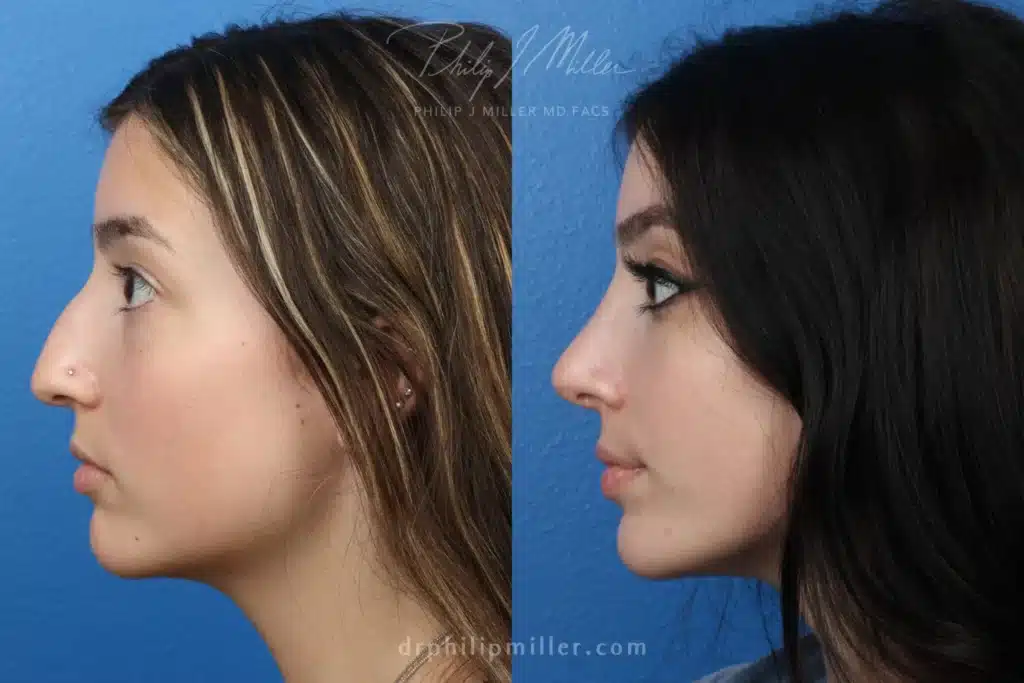
It is best to discuss your allergy history with your surgeon before undergoing nasal surgery. You can work out the right schedule for your surgery, and ideally, your surgeon will enhance the appearance of your nose while correcting any functional issues that affect your breathing.
How Rhinoplasty Can Help with Seasonal Allergies
Septoplasty, also referred to as corrective rhinoplasty, is a surgical solution for a deviated septum. If you have a deviated septum and seasonal allergies, straightening the septum can significantly ease your discomfort during allergy season.
Deviated septum and allergies often go together. While a deviated septum does not cause allergies, it can exacerbate the severity of allergy symptoms like congestion and sneezing.
Turbinates act like the tonsils of your nose. They are projected structures that help filter and humidify the air you breathe. They can become swollen when allergies flare up.
Turbinate reduction surgery can be performed as part of a rhinoplasty. By reducing the size of your turbinates, you experience less congestion and have an easier time breathing even with allergies.
Nasal polyps are small spherical growths that appear along the nasal passages, often as a result of the inflammation caused by allergies. Seasonal allergies may cause small nasal polyps to form. Large polyps can worsen allergy symptoms and affect airflow.
Polyps can be fixed during rhinoplasty to reduce congestion and improve breathing –both providing relief from your seasonal allergies.
Can a Nose Job Treat My Allergies?
No surgery is available to treat nasal allergies. Allergies are caused by immune responses to allergens (e.g., dust, pollen, and smoke) and not structural problems of the nose.
However, rhinoplasty can address conditions that worsen the symptoms of allergies, such as nasal polyps, turbinate hypertrophy, or a deviated septum. While these conditions aren’t responsible for the allergies themselves, they can make it more difficult to breathe when allergies strike.
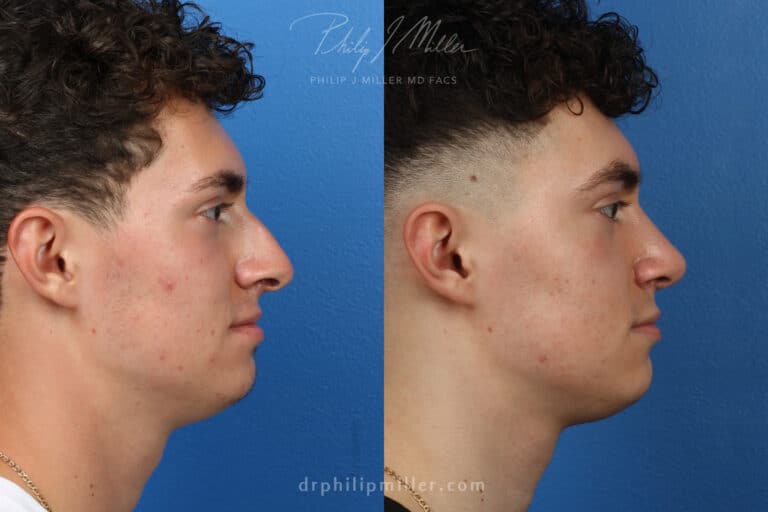
Learn more about allergies at the Mayo Clinic.
Septoplasty vs. Rhinoplasty for Allergies
Rhinoplasty and septoplasty can improve the function of your nose so you can breathe easier. While a septoplasty is focused on fixing a deviated septum and addressing functional issues, a rhinoplasty will also improve the aesthetic appearance of your nose.
Deciding which nose allergy surgery is best should depend on your specific concerns and goals. Consulting with your surgeon is crucial. Your surgeon will ask about your medical history, allergy history, and medications, as well as the cosmetic and functional goals you want to achieve. Your surgeon can then recommend the best surgical approach for your unique case.
Getting Nasal Surgery for Allergies in New York City
Double-board certified facial plastic surgeon, Philip J. Miller, MD, FACS, blends art and science with innovation and skill to provide thousands of patients with impeccable results. Considered one of the country’s leading experts in rhinoplasty and facial rejuvenation, Dr. Miller and his highly acclaimed team are proud to offer patients the highest level of care and customized treatments in New York City.
Dr. Miller developed the NatraLook methodology for his cosmetic procedures for the face. NatraLook is a specialized consultation process through which Dr. Miller will evaluate your facial features and listen to your concerns and goals. He will reassure and support your opinions positively, creating a collaborative environment that gives you a real say in your own procedure. This opportunity allows patients and Dr. Miller to create a unified vision for optimal results and the most natural outcome possible.
If you’re considering nose surgery for allergies, other functional concerns, or cosmetic reasons, schedule a consultation with Dr. Miller in Manhattan, New York, or New Orleans, Louisiana today.
Next, read more about nose surgery for breathing here.
Nose Taping After Rhinoplasty
Nose taping is a common practice among rhinoplasty patients. It is a bandage or tape used during rhinoplasty recovery to support the nose, decrease swelling, and improve the nose’s appearance. Philip Miller, MD, FACS, often recommends nose taping to enhance a patient’s healing process after nose surgery, provided it’s done correctly.
What are the benefits of nose taping after rhinoplasty?
Nose taping after rhinoplasty is beneficial for many reasons. The primary benefit is that it helps to decrease swelling fluctuations after the procedure. It also helps improve:
- Bruising
- Bleeding
- Breathing
- Healing process
- Final appearance
Some patients choose to tape their noses daily or multiple times per day to help them feel better. However, it is most commonly recommended at night when swelling is most likely to occur. It is not necessary to tape during the day unless specified by Dr. Miller.
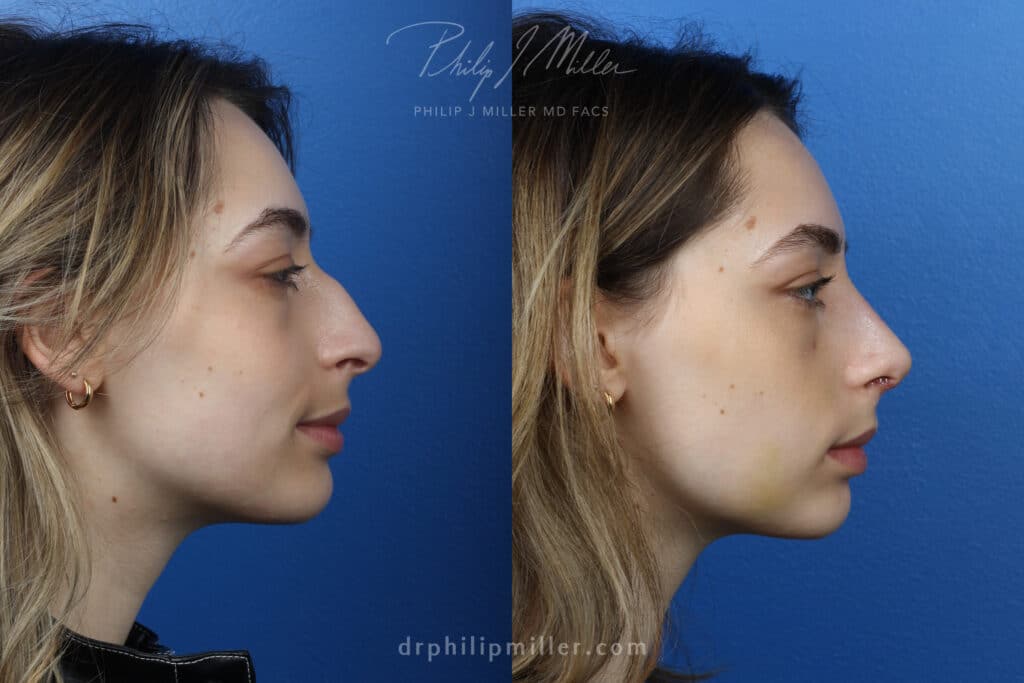
What if I don’t tape my nose after rhinoplasty?
Not all patients have to tape their nose after rhinoplasty surgery; it should only be done following instructions from a skilled board-certified facial plastic surgeon. Dr. Miller works closely with each patient to determine the benefit and necessity of nose taping. There are cosmetic and health benefits associated with taping. If the nose taping process is not followed as directed, it could lead to:
- Nose deformity
- Extended healing time
- Additional complications
- Increased swelling
How to Tape Your Nose after Rhinoplasty
There are multiple kinds of tape to use after rhinoplasty. Common choices are adhesives, like medical tape and bandages, and those that use pressure, like dental bandages. Speak to your surgeon about taping instructions best suited for your situation and healing expectations. Generally, patients should:
1. Tape the nasal bridge: Use 3-5 strips of tape about two inches long. Start at the tip of your nose and overlap upward to cover the entire bridge.
2. Wrap the tip: Use a longer piece of tape to wrap the end of the nose, creating a “U” shape while avoiding the nostrils.
3. Repeat the first step: Repeat the first step using strips to cover the bridge and ensure the “U” tape stays in place.
At first, nose taping may be necessary 24/7, depending on your specific circumstances. In this case, the tape should be removed every 2-3 days and new tape applied. After several days or weeks, nose taping may only be done at night to help with swelling and removed each morning.
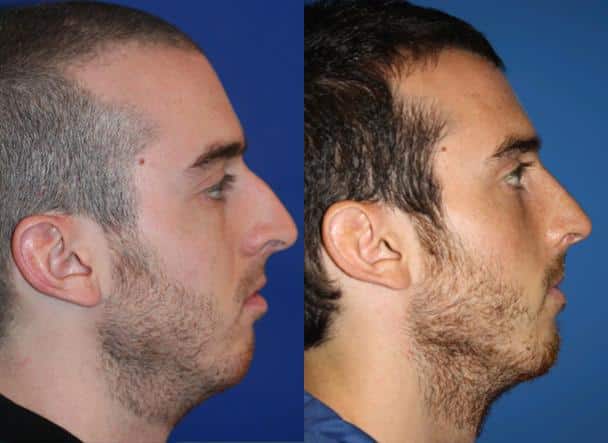
Removing tape should be done with as much care as applying the tape to prevent any harsh movements or pressure. Tweezers can be used to gently peel the tape or remove it after a shower when it is damp and starting to lose adhesiveness, or apply baby oil on the tape and that will loosen it.
How long should I tape my nose after rhinoplasty?
Nose taping is often recommended for 1-3 months after a rhinoplasty procedure. Dr. Miller provides patients with clear instructions for recovery care and taping. Patients will also visit Dr. Miller for follow-up appointments to ensure proper healing and appearance.
Schedule Your Nose Job in NYC
Dr. Philip Miller, MD, FACS, is a world-class, double board-certified plastic surgeon and a leading expert in rhinoplasty procedures and facial rejuvenation. Dr. Miller has more than 20 years of experience in surgical and non-surgical facial procedures and an artistic eye for helping patients meet their cosmetic goals. After a rhinoplasty or revision rhinoplasty procedure, may instruct patients to tape their nose, but it is not always recommended.
Dr. Miller is an innovative expert that offers personalized care and treatment plans. His goal is to empower patients and support aesthetic confidence. Dr. Miller uses the NatraLook® Process to create a positive environment where patients can discuss obstacles and desires for a unified and natural rhinoplasty result.
Contact us to schedule a consultation and learn more about nose taping after rhinoplasty.
Popular Plastic Surgery Procedures: A look at the Real Housewives
Plastic surgery helps individuals achieve the aesthetic beauty and confidence they desire. Bravo’s Real Housewives are open about and supportive of plastic surgery to enhance or change facial and body features. The women had a wide range of treatments in 2021 and spoke candidly on their shows and social media platforms.
Philip J. Miller, MD, FACS, a distinguished double board-certified facial plastic surgeon with more than 20 years of experience, offers these procedures in Manhattan, New York. He is recognized as an expert in rhinoplasty and facial rejuvenation procedures and is known for his innovative techniques and focus on natural-looking results. Dr. Miller and his team of experts can perform the procedures the Real Housewives had done this year; take a look at some highlights:
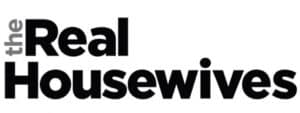
The Nose Craze
Rhinoplasty was a big hit among the Real Housewives in 2021. Teresa Giudice and Raquel Leviss—to name two—both had rhinoplasty procedures. Many patients feel their nose detracts from other facial features and choose rhinoplasty to adjust the shape or size to fit harmoniously with the rest of their facial features.
Rhinoplasty is a complex procedure that requires a skilled and experienced surgeon, as well as extensive preoperative discussions and planning. Dr. Miller considers facial structure, the prominence of features, and skin quality and thickness when advising patients on how to achieve their cosmetic goals and overall facial balance.
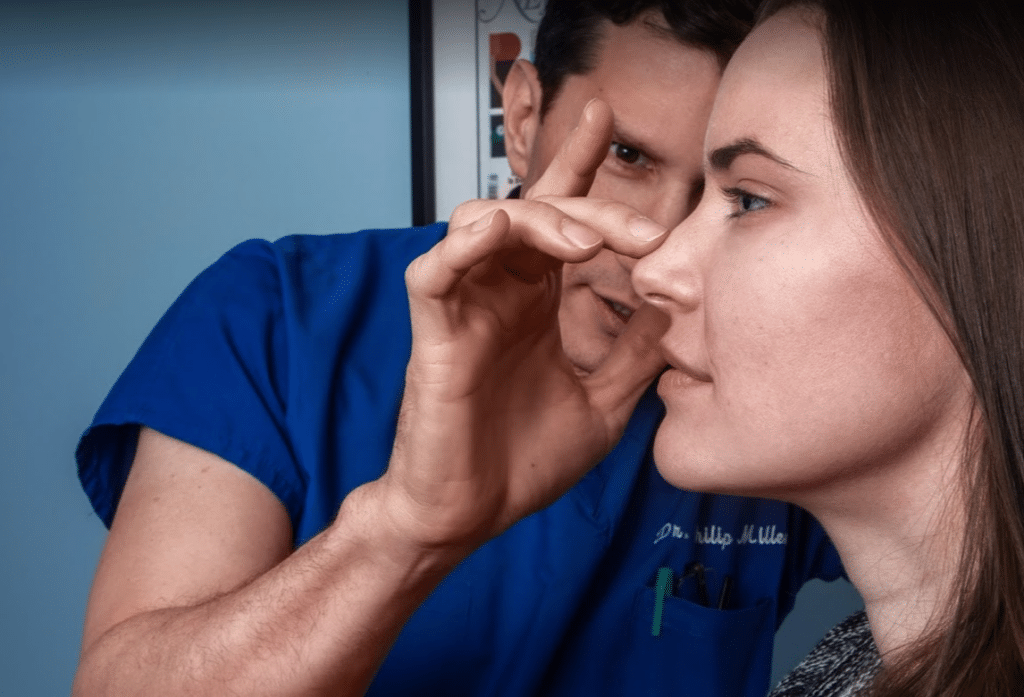
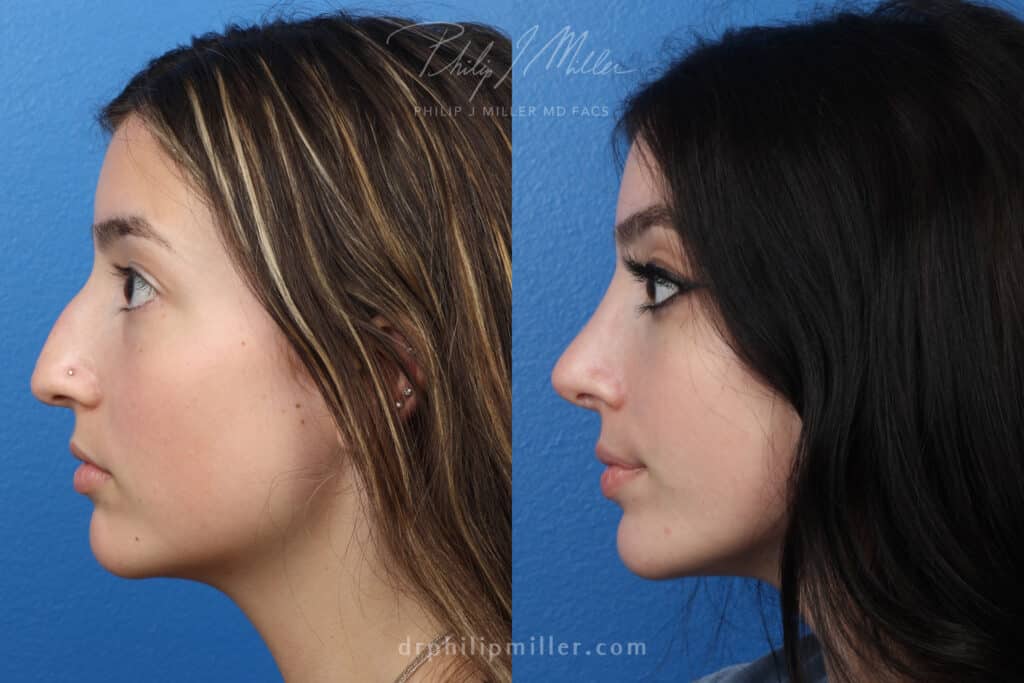
In the case of Real Housewife Raquel Leviss, she felt disappointed with her results and thought her fiancé bumping into her nose may have contributed to unwanted results. While finding an expert surgeon is important, sometimes results can be different from what a patient envisioned. Dr. Miller offers revision rhinoplasty for patients disappointed in results, or that suffered a nose injury or trauma after the initial procedure.
Rhinoplasty can tackle a small problem area or completely reshape or resize your nose. Teresa Giudice felt her nose was too round on the top and turned to rhinoplasty to feel more confident. Whatever the reason, whatever the concern, Dr. Miller can work with you to find a solution and create natural, beautiful results for you.
Combining Procedures
Many plastic surgery combinations are safe and provide maximum results. By combining procedures, patients can reduce recovery time, limit the use of anesthetics, and eliminate multiple surgeries. Some procedures make sense to perform together, such as a facelift and fillers, or chin augmentation and rhinoplasty.
Combination procedures have been popular with many of the Real Housewives, as the convenience of scheduling multiple treatments at one time can save both time and money.
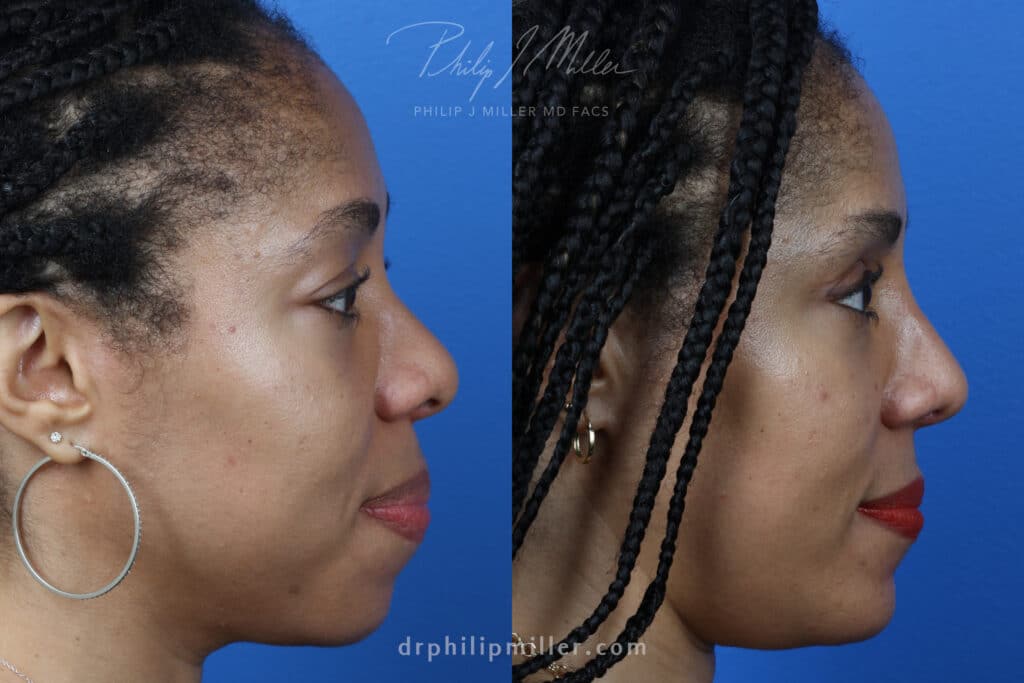
Dr. Miller works closely with patients to identify their cosmetic goals and create a custom plan with combination treatments to meet those goals quickly and efficiently. Like Jennifer’s case, sometimes balance can only be achieved when multiple areas are addressed with different procedures. Seeing satisfying results from combination procedures can boost your confidence and comfort.
Getting a Lift
Facelifts—and other major plastic surgeries—are most common in the fall and winter to avoid heat and sun exposure and see results before summer months or holiday events. A facelift is a popular procedure that tightens sagging skin from aging and weak muscles. Loose skin can be moved or removed to create a natural look and a more youthful appearance.
Dolores Catania and Emily Simpson are two Real Housewives that have undergone a facelift. There are different types of facelifts that produce various levels of results. Emily had a mini lower facelift which is less invasive and targets more minor areas of wrinkles or loose skin. Dr. Miller offers different types of facelifts in his Manhattan office, including:
- Traditional Facelift: Incisions are made at the hairline, continue in front and behind the ears, and extend to the lower scalp. Muscles and skin are lifted and tightened, and closed with sutures.
- Mini Facelift: This procedure uses shorter incisions and targets areas that are just beginning to wrinkle or sag. This minor outpatient treatment can be accomplished in less than 90 minutes.
- Thread Lift: A unique thread with tiny barbs is used to pull the skin up and back. This thread latches onto the skin and remains in place to keep the skin smooth.
- Micro Lift: This minimally invasive procedure creates the look one achieves with pulled-back hair. It is a quick and safe procedure with little downtime.
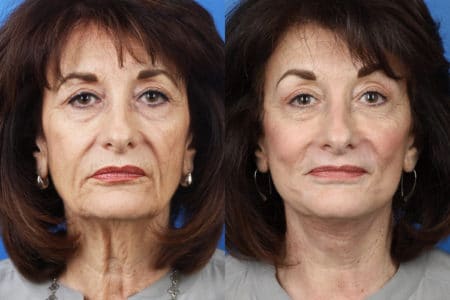
Fast and Fabulous
Dermal fillers and Botox ® Cosmetic are popular, especially among Real Housewives. Botox treats frown lines and other dynamic wrinkles by blocking nerve impulses to facial muscles, while dermal fillers target static wrinkles and restore youthful volume. Knowing the right product, treatment area, and limit is key to achieving your best possible results.
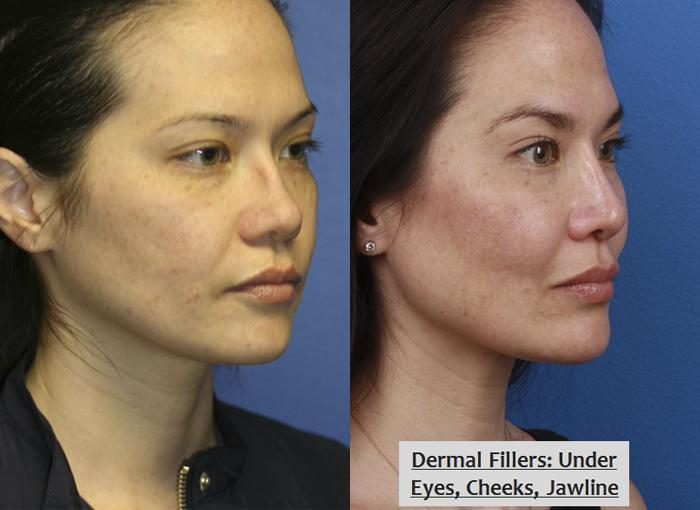
Real Housewife Shannon Storms Beador admitted to overdoing it on fillers. When too many facial fillers are used, it can dramatically alter an appearance and create disproportionate features and an unnatural look. Dr. Miller uses the unique NatraLook® approach to aesthetic beauty. The NatraLook process empowers individuals to explore aesthetic confidence safely and naturally. Dr. Miller and his team strive for natural-looking results to provide patients with an extraordinary experience.
Dr. Miller can suggest which Botox and filler treatments are right for you to create the customized approach that produces the most natural improvement.
Your Best Choice for Facial Plastic Surgery in New York City
Many plastic surgery procedures help you look and feel your best. Whether you want a single treatment, combination procedure, or a total makeover, Dr. Miller can help you achieve your aesthetic goals. NYC #1 facial plastic surgeon, Dr. Miller, uses minimally-invasive techniques, innovative technology, and advanced surgical methods to help patients boost their confidence and achieve their aesthetic goals.
Contact us today to learn more about our procedures and schedule a consultation.
Your Most Beautiful Nose: Understanding Your Nose Type
Manhattan, New York, is a diverse city representing many ethnicities. While everyone has a unique nose shape, common ethnic features impact rhinoplasty concerns and ideal outcomes. Rhinoplasty, better known as a nose job, is a surgical procedure that improves the appearance of the nose by:
- Reshaping
- Reducing
- Straightening
- Removing a hump
- Refining the tip
Customizable rhinoplasty solutions are essential to achieve the most natural results, especially for ethnic rhinoplasty patients. Ethnic rhinoplasty is a procedure performed on patients of different ethnicities and can improve the nose while preserving ethnic identity.
Philip J. Miller, MD, FACS, is a double board-certified facial plastic surgeon surgeon with skill, expertise, and an artistic eye. He achieves impeccable and life-changing results for his patients and is highly qualified to perform even the most complex rhinoplasty procedures. He uses a unique approach with ethnic patients as their goals and concerns typically vary from Caucasian patients.
Dr. Miller’s Manhattan office works with many different nose types, including:
African American Noses
African American rhinoplasty is an ethnic reshaping procedure designed with specific and unique characteristics and concerns of African American patients. African Americans tend to have:
- Wide, low bridge
- Bulbous, under-projected tip
- Wide alar base
- The goal for many African American rhinoplasty procedures is to:
- Low bridge
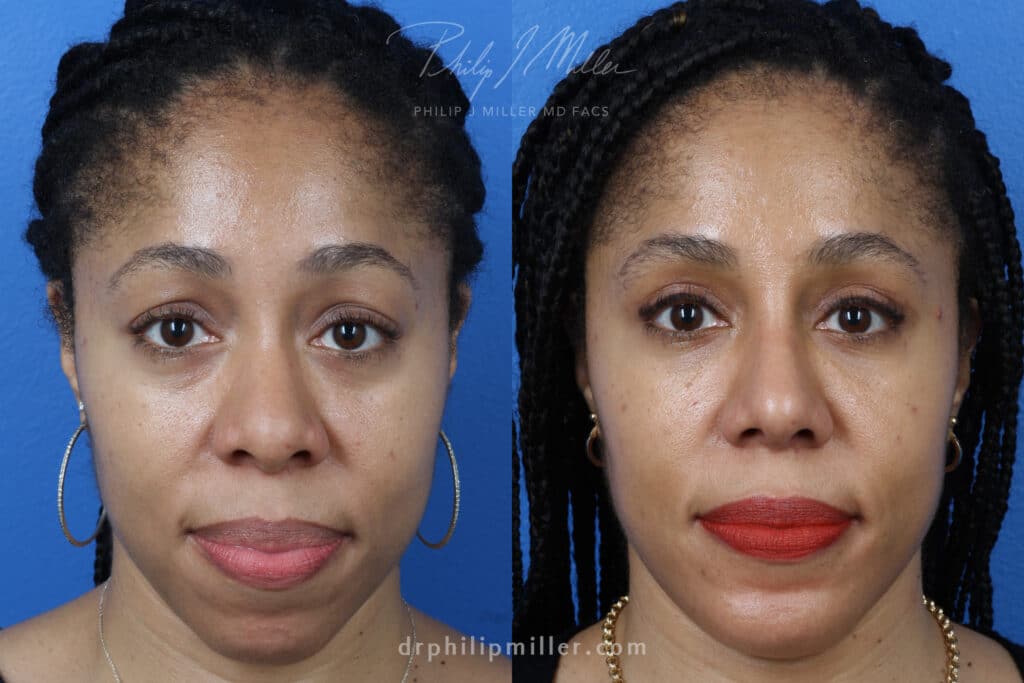
Dr. Miller recognizes the differences in nasal anatomy and can improve the nose while maintaining harmony with other facial features and ethnic heritage. As a skilled and experienced surgeon, Dr. Miller creates natural outcomes and avoids complications common in African American patients, such as keloid scar formation.
Asian Noses
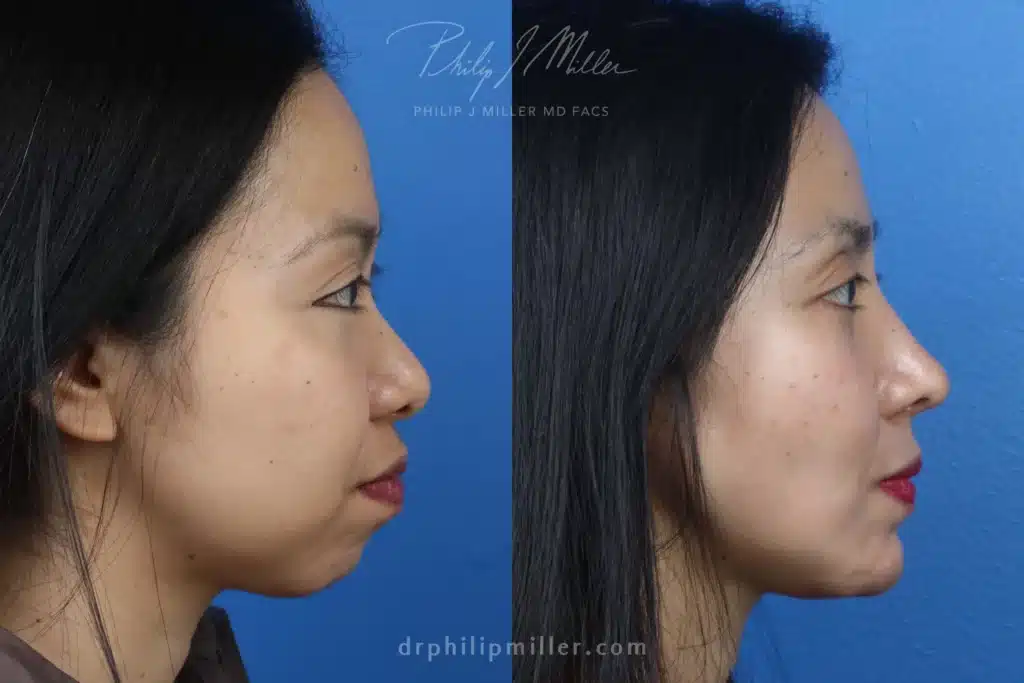
Each ethnicity has a different look and requires a specialized approach to rhinoplasty, including Asian patients. Many Asian patients experience common nose characteristics, including:
- A flat nasal profile
- A slight nasal bridge
- Flared nostrils
- A wide nasal tip
- Poor nasal tip strength
Asian patients often want to:
- Reduce flaring
- Have tip or bridge implants for a more prominent profile
While Korea is an Asian country, Korean rhinoplasty varies from the approach to Asian rhinoplasty. Korean patients experience a flatter nasal profile, slight nasal bridge, broad nasal tip, and wide nostrils. Without overcorrecting, Dr. Miller can:
- Narrow nostrils
- Fix an overly punched tip
- Correct an over-augmented bridge
Dr. Miller is committed to creating a personalized treatment plan with an approach central to your ethnicity. With more than 20 years of experience, Dr. Miller can produce natural and beautiful results in his Manhattan, New York location.
Hispanic/Latino Noses
There are more than 52 million Hispanic and Latino individuals in the United States, making Hispanic rhinoplasty an increasingly popular procedure in Manhattan. There is so much diversity within the Hispanic and Latino communities, it requires special consideration for small ethnic groups regarding rhinoplasty procedures. Hispanic patients share common nasal features such as thick skin and a bulbous nasal tip that is difficult to refine with traditional methods. Other categories include:
- Spanish heritage: a large bridge
- Caribbean heritage: wide, flat nostrils
- Central and South American heritage: flatter nasal tips and bridges
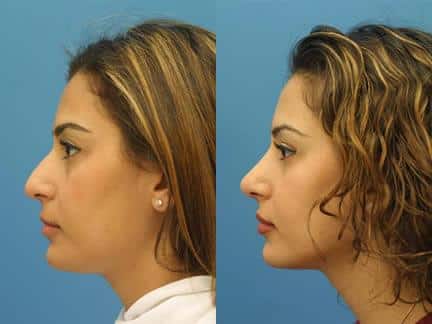
These differences call for three distinct rhinoplasty procedures:
- High bridge with a hump: The cartilage is shaved down, and the bone is rasped to remove the hump
- Under-projected, dependent tip: The tip of the nose is raised and projected with supplemental cartilage
- Shorter, flatter nose with a broad nasal base, thick skin, and a wide tip: The shape of the nose is refined by narrowing the base and raising the bridge
Dr. Miller works extensively with patients on how to approach the procedure and how to maintain a natural and ethnic-looking appearance.
Middle Eastern Noses
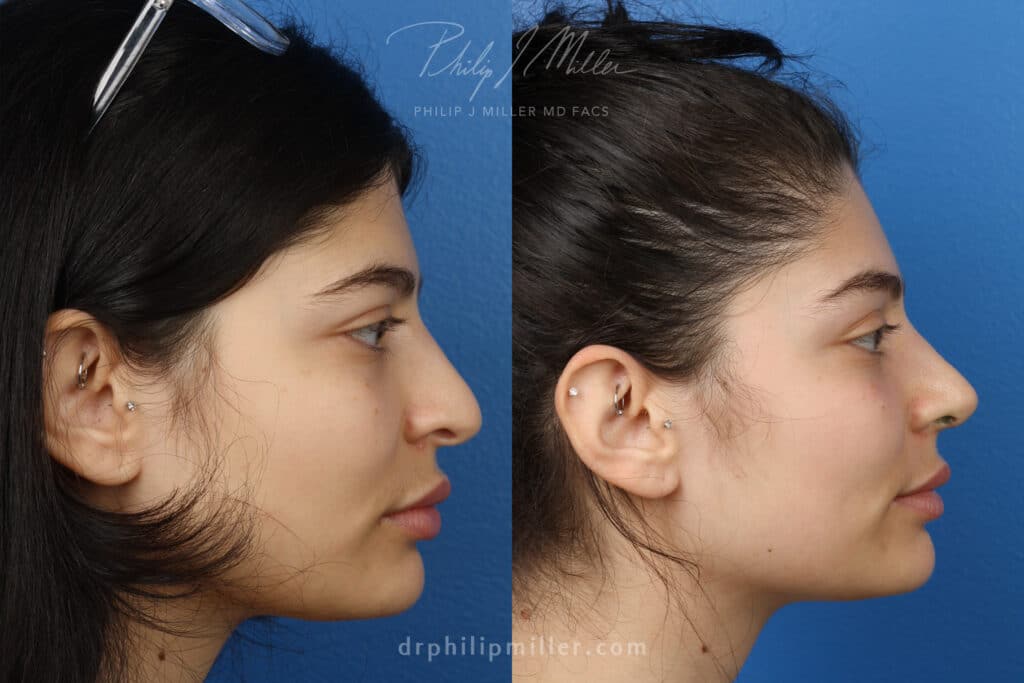
Mediterranean and middle eastern rhinoplasty patients experience common nasal characteristics such as:
- Thicker facial skin with fattier tissue
- Longer noses and a higher bridge
- Droopy tips
- Nasal humps
- Asymmetrical nostrils
- Wide bones
The goal of middle eastern rhinoplasty is to create:
- More symmetry
- Facial balance
Less experienced surgeons may create undesirable results, but Dr. Miller is a skilled surgeon that is knowledgeable about ethnic nose reshaping techniques. He can help create the best nose with ethnic rhinoplasty or revision rhinoplasty.
Indian Noses
With special techniques and years of experience, Dr. Miller can improve the shape of Indian noses without impacting ethnic identity with Indian rhinoplasty. Common nose characteristics for this ethnicity include:
- Rounder nasal tip
- Wider nasal structure
- Thicker skin on the nose
- A nasal shape that slopes downward
- Hump or bump on the nasal bridge
You can schedule a consultation in Dr. Miller’s Manhattan office to discuss all your concerns and identify if Indian rhinoplasty is right for you.
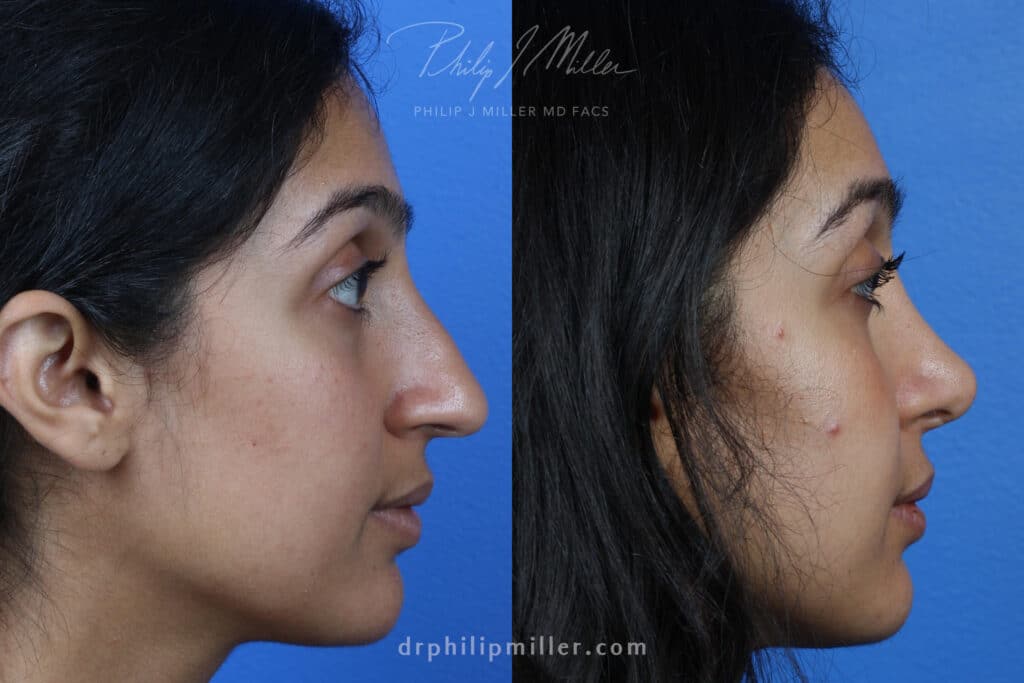
Other Types of Noses
There are many other ethnic nose shapes such as Greek, Persian and Jewish noses. Greek noses typically have a straight bridge without bumps or curves. It is a common reference as many rhinoplasty patients want a straight bridge for a sleek-looking profile.
A Persian nose has:
- Large nasal profile
- Downward sloping of the nasal bridge
- Bulbous nasal tip
A Jewish nose has:
- Amorphous nasal tip
- Over projected nasal tip
- Large dorsal hump
Getting Positive Results with Ethnic Rhinoplasty
Dr. Miller utilizes the NatraLook® Process to ensure the most natural and pleasing results for any procedure, especially complex treatments like rhinoplasty. The NatraLook Process is critical to achieving a unified vision and executing intended results specific to ethnicity. Evaluating the entire face is vital to achieving balance, beauty, and natural-looking features.
#1 NYC facial plastic surgeon, Dr. Miller, has years of experience with ethnic patients and has the skills to create natural and ethnically centered rhinoplasty procedures. Contact Dr. Miller’s Manhattan, New York, office to schedule a consultation and learn more about ethnic rhinoplasty.
What is Dorsal Reduction?
Dorsal reduction rhinoplasty surgery is a procedure that removes excess cartilage and bone from the nose, refining its appearance and improving its proportion to the rest of the face.
Philip J. Miller, MD, FACS, a double board-certified facial plastic surgeon in Manhattan, New York, and one of the country’s foremost experts in rhinoplasty, can assist female and male patients alike in achieving a nose they’ll love. You may elect traditional dorsal reduction rhinoplasty to reshape or reduce the nose. Other patients may benefit from non-surgical rhinoplasty for subtle corrections that achieve their desired aesthetic goals.
What is dorsal reduction?
Dorsal reduction rhinoplasty is a surgery that removes excess cartilage, bone, and skin from the nose, giving it a straighter, more streamlined look. This can help enhance the appearance, create facial symmetry, and improve breathing through the nose by reducing nasal obstruction or deviation.
The procedure can make the bridge of the nose narrower and straighter, and is often performed on patients whose noses are too large for their facial features or who have noses with an unusual shape. Dorsal reduction is often performed on people with prominent noses, such as those of Italian or Greek heritage.
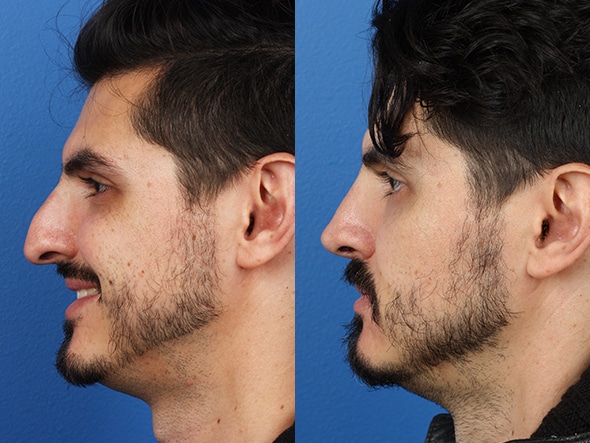
What causes a dorsal hump?
A dorsal hump appears on the slope of the nose from the bridge to the tip and can affect your facial profile. A dorsal hump is most noticeable when viewed from the side of the face.
The majority of dorsal humps are inherited genetically. As a result, if your parents or siblings have a prominent dorsal hump, you may as well. Dorsal humps may occur due to a traumatic physical injury—such as a sports injury or car accident—if the bone or cartilage heals unevenly. Whatever the cause of a dorsal hump, Philip Miller, MD, FACS in Manhattan can correct it and give you an aesthetically pleasing, balanced profile.
Benefits of Dorsal Reduction

The benefits of dorsal reduction rhinoplasty include improved self-confidence and a positive self-image. However, since dorsal humps are often the result of genetic heritage, the procedure may cause identity issues for some ethnic patients. This is why it is so important to rely on an expert surgeon’s skills to achieve the goals of an ethnic nose job without affecting other ethnicity-related facial features.
How is dorsal reduction performed?
Open Rhinoplasty. During an open rhinoplasty, the surgeon makes a small Z-shaped incision between the nostrils on the underside of the nose. The open approach enables the surgeon to make more precise and accurate adjustments to your nose’s shape. Although open rhinoplasty leaves a small scar, it fades quickly with proper care.
Closed Rhinoplasty. Closed rhinoplasty is a procedure in which the surgeon makes incisions inside the nose without affecting the skin. The primary disadvantage of this approach is that the bone, cartilage, and tissue are not visible to the surgeon. However, this procedure results in less swelling than open rhinoplasty and can correct minor flaws.
MicroRhinoplasty. During a MicroRhinoplasty procedure, Dr.Miller accesses the treatment area via a small incision in the nostril. Then, using a specialized microrasp, he meticulously removes the protruding bony layers until the desired contour is achieved. Patients experience minimal discomfort, swelling, and bruising and typically resume normal activities within a few days.
Liquid Rhinoplasty. A liquid—or nonsurgical—rhinoplasty uses dermal fillers to reshape the nose without stitches or incisions. While liquid filler can’t make a nose appear smaller, it can correct minor indentations or asymmetries without requiring surgical intervention.
Recovery After Dorsal Reduction
Most patients are pleasantly surprised by how little pain they experience following dorsal reduction rhinoplasty surgery. The most unpleasant aspect of postoperative recovery is difficulty breathing through the nose for several days because of swelling. This difficulty usually resolves within a week or two. Expect some swelling around your eyes for several weeks. Once the swelling diminishes, you’ll start to see improvement.
You’ll need to follow certain precautions during your recovery period. Because bending or lifting can exacerbate swelling, it’s not recommended for the first three weeks following surgery. No strenuous activity such as running, weight lifting, cycling, or cardio training should be resumed for three weeks. Contact sports should be avoided for six weeks to allow the bones to heal completely. You may drive once the swelling has subsided sufficiently to allow for clear vision. Air travel is permitted 2-3 weeks after your surgery.
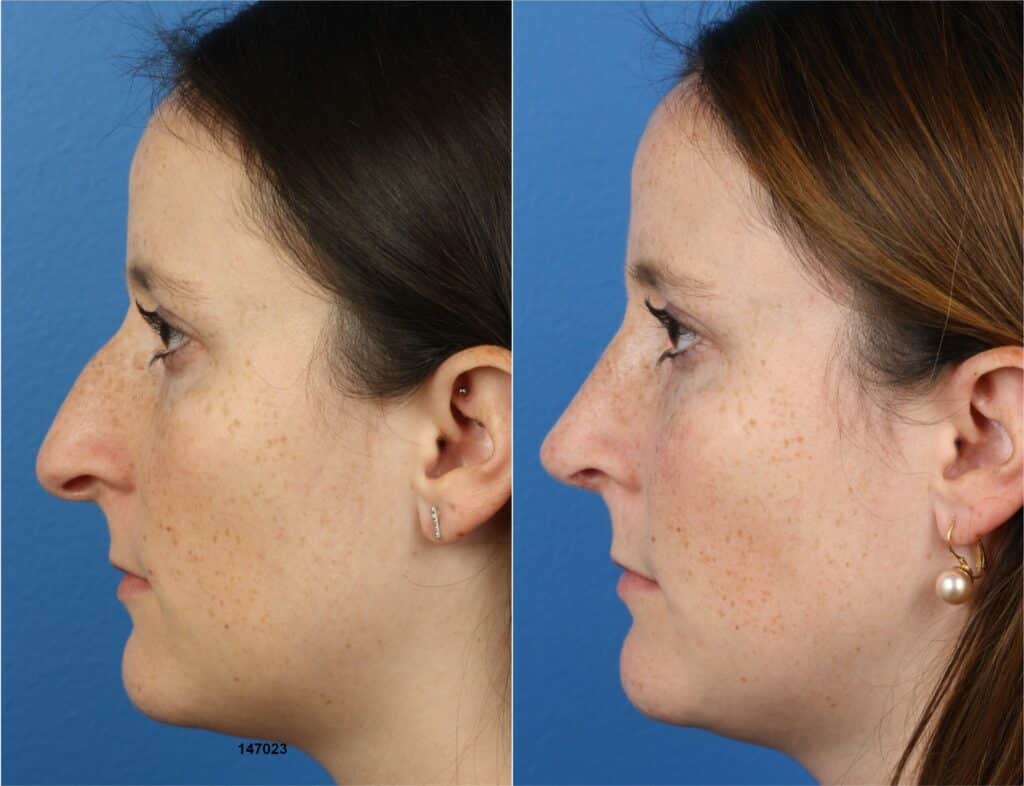
Scarring After Dorsal Reduction
The size and location of scars will depend on how extensive your treatment is because dorsal reduction involves removing sections of bone, cartilage, and skin tissue.
Scars from this procedure are typically hidden within the nasal skin creases and won’t be visible when you look straight ahead. Many patients choose topical treatments to minimize scarring.
Is Dorsal Reduction Right for You? Ask the Expert
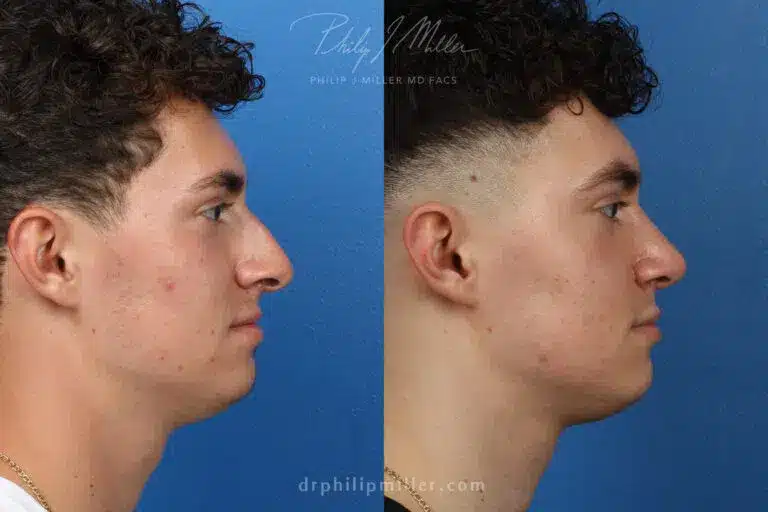
Why should you consult with Dr. Miller about your dorsal reduction procedure?
- Dr. Miller has over two decades of experience in facial plastic surgery.
- He has performed over 5,000 successful procedures.
- He is a facial plastic surgeon of international renown.
- He blends art and science to provide his patients with beautiful, natural-looking results.
In addition to these qualifications, Dr. Miller offers his patients the exclusive NatraLook process, which combines minimally invasive techniques and advanced procedures to help each patient achieve the Aesthetic Confidence® they desire.
Schedule a Dorsal Reduction Consultation in New York
To learn more about dorsal reduction rhinoplasty in Manhattan, contact our office to set up a consultation with Dr. Miller, #1 NYC facial plastic surgeon. You can fill out our convenient contact form or call us. One of our patient advisers will be happy to help you start the journey to a new, improved you.
What is External Rhinoplasty?
One of the most important steps during your rhinoplasty consultation is determining whether you are a better candidate for external (open) or endonasal (closed) rhinoplasty. While both procedures can achieve exceptional results, the exact technique that your facial plastic surgeon uses will be determined by your unique concerns and nasal structure. This blog puts the spotlight on what external rhinoplasty is and its advantages.
Whether you are a better candidate for external rhinoplasty or a different technique, double board-certified facial plastic surgeon, Philip J. Miller, MD, FACS, has the artistic skill and experience to reshape or reconstruct your nose for enhanced facial symmetry. He is your Manhattan, New York, and New Orleans, Louisiana, expert on all types of rhinoplasty techniques, and it is his goal to bring balance to your features and achieve beautiful, natural-looking results.
What is External Rhinoplasty?
External rhinoplasty is a rhinoplasty technique in which Dr. Miller makes a small incision in the columella (the piece of tissue that separates the nostrils) in a Z-shaped pattern. This common technique opens the tip of the nose to reveal its internal structures, improving surgical access and allowing Dr. Miller to fold the nasal skin upwards.
Because of enhanced visibility while maneuvering through the bone, cartilage, and tissue that make up the nose, Dr. Miller can reshape the nose and repair damage without jeopardizing its structural support.
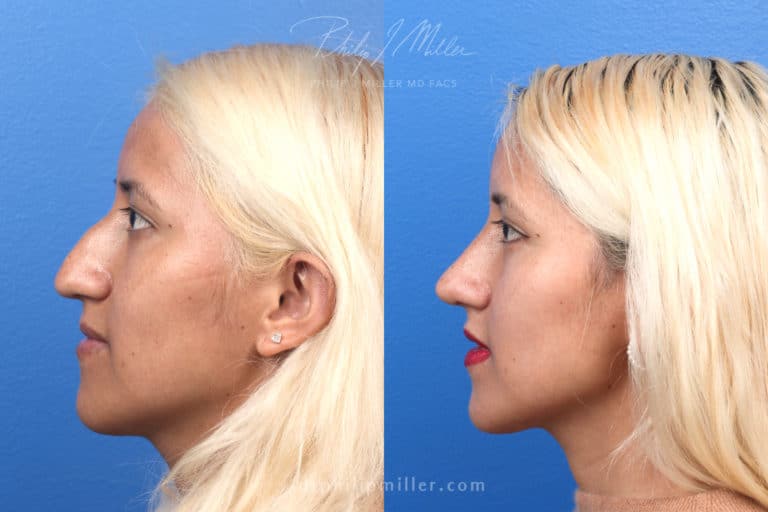
External vs. Endonasal Rhinoplasty
An endonasal rhinoplasty is a procedure in which all incisions are confined to the inside of the nostrils. During the procedure, Dr. Miller carefully lifts the underlying bone, cartilage, and tissue through the nostrils, and while visible scarring is prevented, considerable challenges and technical limitations are associated with the lack of surgical access.
A closed rhinoplasty is especially appealing for those who want to make minor modifications to their nose. It’s also ideal if you have breathing problems, such as chronic sinusitis. And with no external incisions, the skin between the tip and nasal bridge remains intact. This means a shorter recovery time for patients. But this more conservative rhinoplasty isn’t right for everyone.

Dr. Miller typically recommends external rhinoplasties for patients with more complex structural concerns, such as:
- A severely crooked nose
- Nasal trauma or deformities
- An asymmetrical tip
- A large nasal tip
- A large dorsal hump (bump on the nasal bridge)
External rhinoplasty is also best for revision rhinoplasty in most cases. If you’ve had rhinoplasty in the past and are unhappy with the results, Dr. Miller will typically recommend external rhinoplasty to address your concerns.
Benefits of External Rhinoplasty
There are two main advantages to an external rhinoplasty procedure:
Improved precision: The greatest benefit of performing external rhinoplasty is better access. Opening the columella allows Dr. Miller to see the internal structures of your nose. As a result, he can correct complex nasal deformities with precision and accuracy. Clear visibility also allows him to preserve as much of your tissue, cartilage, and bone as possible because he can reshape rather than simply remove them. Many patients may have underlying asymmetry issues with their cartilages, and these can only be visualized and treated through an open approach.
Preservation of structural support: Because of better visualization of almost the entire nasal framework, individual components can be accessed in their natural, undisturbed alignment. And by expanding his entry to the nasal components, Dr. Miller can maintain the nose’s structural stability. He’s able to create dramatic results without disrupting much of the surrounding bone, cartilage, and tissue.
How is External Rhinoplasty Performed?
Dr. Miller begins an external rhinoplasty by making a small incision in the columella. He will lift away nasal skin, pulling it up so he can work on bone and cartilage in their natural alignment. After he makes the necessary alterations to reshape the nose or repair any damage, he will re-drape the skin and suture it in place. A small splint is typically taped over the nasal bridge and will be removed one week after surgery.
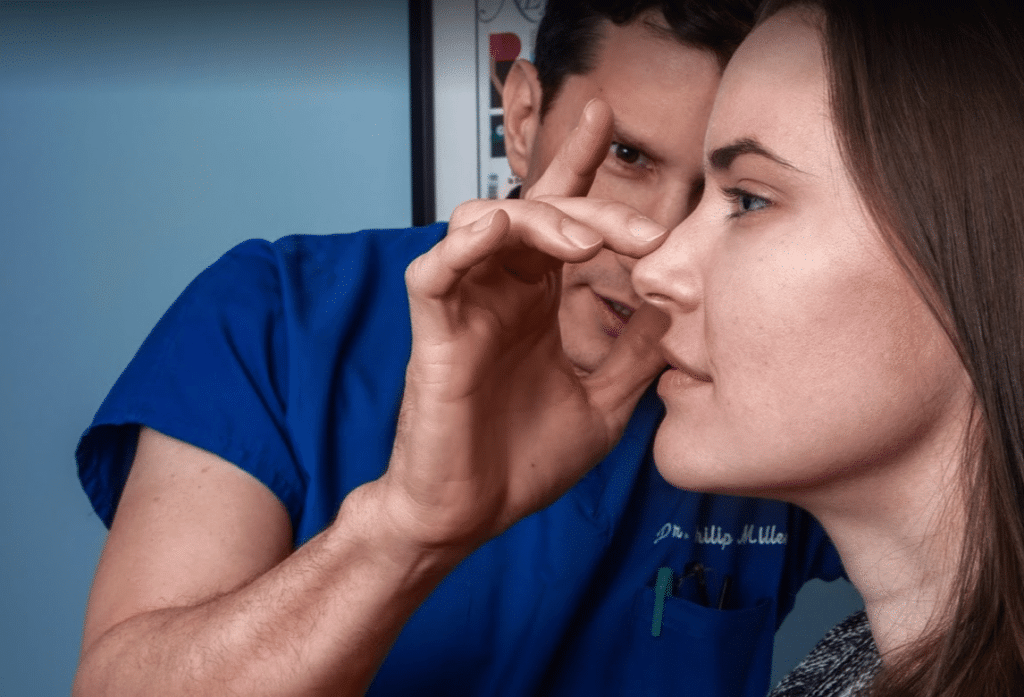
Recovery After External Rhinoplasty
You will experience nasal stuffiness after your procedure which will subside after the first several weeks. The splint, which helps protect and support your nose, will be removed about one week after your surgery. When the splint comes off, you may see some bruising and swelling under the eyes which are temporary and can easily be covered by make-up. Most patients are usually back to performing most activities after 2-4 weeks.
Dr. Miller will provide you with an extensive list of rhinoplasty post-op instructions. This is by far the most effective way to help ensure a smooth post-op recovery process and reduce the chance for risks and complications.
Scarring After External Rhinoplasty

Since an open rhinoplasty requires an external incision, you may have minor scarring after the procedure. Fortunately, the Z-shaped incision is very small, so the scarring should fade with time.
Dr. Miller also takes your skin and facial structure into consideration before making the incision. This step ensures that the scar is barely visible as it is between the nostrils at the base of the nose. In most cases, you will be the only one that knows it’s there.
Is External Rhinoplasty Right For You? Ask the Expert
Determining the best type of rhinoplasty for you depends entirely on the concerns you want to address. Neither technique is necessarily better than the other.
To ensure you achieve the best results possible, Dr. Miller offers a proprietary consultation process called NatraLook. During your NatraLook consultation, he evaluates your nose and facial features while listening to your concerns and goals. This process expands the typical plastic surgery experience into a safe, collaborative environment where you can explore your aesthetic confidence and create a unified vision for your outcome.
Contact an Expert Facial Plastic Surgeon to Learn More About Rhinoplasty in New York City
To learn more about the different types of rhinoplasty procedures Dr. Miller performs and to find out which technique is best for you, contact our New York City plastic surgery clinic today.
5 Clues You Might Need Revision Rhinoplasty
Problems with your rhinoplasty procedure? Not happy with the results? Don’t lose hope—you can still achieve the look and functionality you want with revision rhinoplasty. Revision rhinoplasty is a surgical procedure to correct undesirable outcomes or treat persistent issues the original surgery did not address.
Philip Miller MD, FACS, a double board-certified facial plastic and reconstructive surgeon, can perform successful rhinoplasty and revision rhinoplasty procedures in Manhattan, New York. Dr. Miller has more than two decades of experience performing surgical and non-surgical procedures and can help you reach aesthetic confidence with revision rhinoplasty.
Why is revision rhinoplasty so common?
Revision procedures are common because the initial rhinoplasty is one of the most complex of all plastic surgery procedures. Some plastic surgeons do not have the skills, experience, and training to perform this procedure well, leading to botched surgeries and undesirable results.
The nose contains thin cartilage that requires expert handling to achieve successful cosmetic or functional outcomes. A study from the Aesthetic Surgery Journal found the average rate for revision rhinoplasty to be nearly 10%. Other factors that include increased revision rhinoplasty rates include:
- Outdated techniques or equipment
- Lack of doctor-patient communication
- Complications that impact the healing process and results
There are several common indicators that revision rhinoplasty may work for you. Take a look:
Clue #1: Your Nose is Not Symmetrical
Many patients feel their nose looks asymmetrical after rhinoplasty and that it was not adequately shaped. A poorly performed rhinoplasty procedure can result in a nose that appears uneven, disproportionate, or even off-center. Revision rhinoplasty can create a more natural, even look to compliment your entire facial structure.
After completely healing from rhinoplasty, you can assess the symmetry of your nose, and if you are unsatisfied, revision rhinoplasty may be right for you.
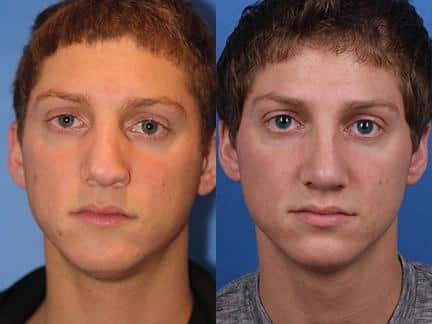
Clue #2: Your Results don’t Look Natural
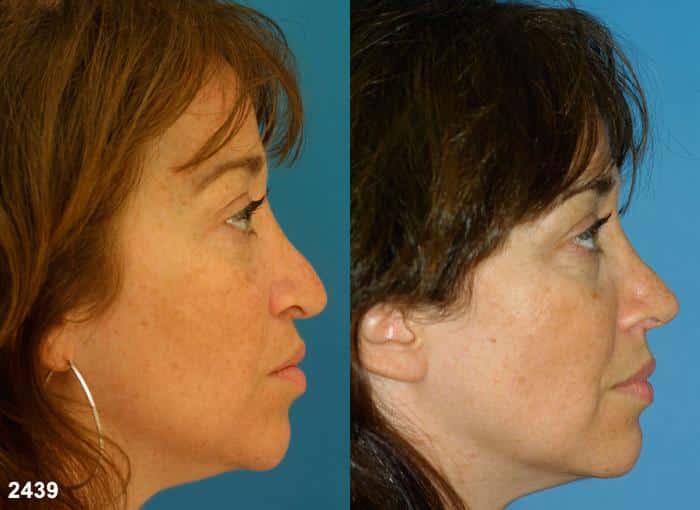
An initial rhinoplasty procedure may have removed too much or too little tissue and can lead to an unnatural nose shape. It can also cause a build-up of scar tissue that needs to be surgically removed. Unnatural-looking noses can be resolved with revision surgery. Potential unnatural-looking results include:
- Pinched Tip: A frequent complaint where the end of the nose appears compressed and leads to unwanted aesthetics and impaired breathing. This occurs when too much cartilage is removed from the tip of the nose, diminishing support over time.
- Short Nose: Just as it sounds, a nose can appear short and stubby due to the removal of too much cartilage. Specialized grafts act as support and restore a longer, more natural-looking shape.
- Crooked Nose: Typically derived from nasal trauma or a result of an initial rhinoplasty, a crooked or twisted nose is uneven and unnatural. Revision can rearrange the cartilage and bone to create a symmetrical, pleasing look.
Dr. Miller utilizes the NatraLook® Process to ensure the most natural and pleasing results. The NatraLook Process is critical to achieving a unified vision and executing intended results. Evaluating the entire face and how features relate to each other, as well as skin quality and thickness, all play a part in creating a beautiful, natural look.
While an unsatisfactory rhinoplasty can be very upsetting to a patient who has invested time and money into the process, many issues can be resolved with revision rhinoplasty. Dr. Miller performs revision procedures in his Manhattan, New York office to restore your confidence and achieve a natural look.
Clue #3: You are Disappointed in Your Results
If doctor-patient communication was lacking, or the procedure did not go as planned, many patients can feel disappointed in the results. Skill and experience are not the same. Surgeons may know how to do some nose shapes and resizing but may not have as much experience with a broader range of requests and or techniques. Your nose should be proportional and harmonious with other facial features, which means rhinoplasty is not a one-size-fits-all endeavor.
Even if the shape is ideal, patients may find other imperfections that cause dissatisfaction. Revision rhinoplasty can refine subtle areas such as:
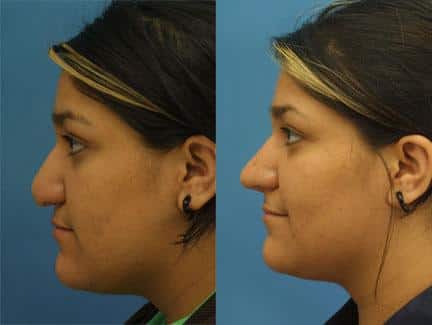
- Narrowing the nostrils
- Lifting the nasal tip
- Thinning or lifting the tissue that separates the nostrils
- Smoothing bumps on the surface of the nose
Revision rhinoplasty is a solution for major or minor alterations so that you feel good about your look. Dr. Miller uses his years of expertise to create patient-centric plans that result in stunning aesthetics to satisfy individual beauty goals.
Clue #4: Your Nose isn’t Working Properly
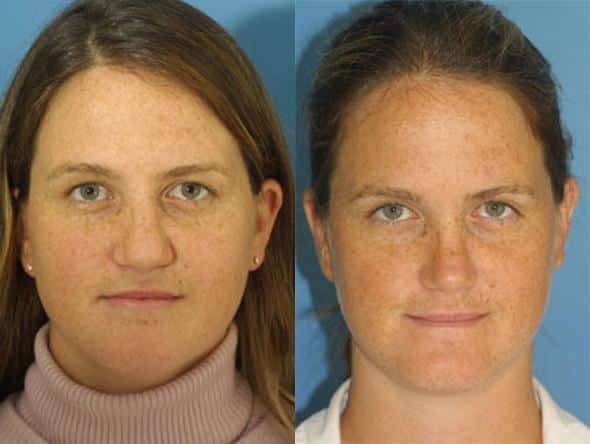
Not only should your nose look amazing, but it should also function properly. Improper nose function can be due to rhinoplasty surgery that does not heal properly or a functional issue that was not resolved or was created from a rhinoplasty procedure. The nose is a significant structure that impacts breathing and sinus issues. Revision rhinoplasty can help you get your dream nose and optimize function to reduce or eliminate problems that can interfere with breathing and sleep.
Clue #5: An Injury Occurred Since Your First Surgery
Rhinoplasty is a superior choice for nose shaping and sizing, but it does not make your nose invincible. The nose is still susceptible to injury and trauma, especially within a year or two after surgery. Due to the restructuring of cartilage and tissue, the nose can often be more fragile. If you endure an injury or trauma to the nose, it can be repaired through revision rhinoplasty. Dr. Miller works closely with Manhattan patients to ensure cosmetic and functional concerns are addressed when trauma or injury has occurred.
How Long Should You Wait for Revision Rhinoplasty?
Healing varies by individual, but most surgeons request patients wait 12-18 months before undergoing secondary rhinoplasty surgery. The healing process is long and crucial for the nose to take its final form or function. The duration of swelling varies by patient and can cause the nose to look different than it will when completely healed. Rushing into a revision surgery is dangerous and can cause unnatural and unsatisfactory results.
Choosing Your Revision Rhinoplasty Surgeon
Plastic surgery is not a guaranteed process, but choosing an expert surgeon with years of experience and developed skills can positively impact results. Do not assume all plastic surgeons are the same—research a surgeon and their practice before committing, and do not be afraid to ask hard questions. A consultation is a time to learn more about the procedure, a surgeon’s credentials, and experience.
Dr. Miller is a highly reputable, double board-certified plastic surgeon with more than two decades of experience in cosmetic medicine. With his expert team, Dr. Miller has a high success rate of facial surgery procedures and has been voted among the Best Doctors in America for the past 10 years and Top Doctor of New York City. He uses innovative techniques for rhinoplasty and revision rhinoplasty that helps patients achieve their desired look and function.
Contact us today online or by calling 646-791-3025 to see if revision rhinoplasty is right for you.
5 Rhinoplasty Trends in 2022
Rhinoplasty surgery was the most frequently requested cosmetic surgery in 2020, with over 352,000 procedures performed.
Facial plastic surgeon, Dr. Philip Miller in New York City—one of the country’s leading experts in rhinoplasty and facial rejuvenation—can help you achieve a nose you’ll love. You may choose traditional rhinoplasty to reduce or reshape the nose. For other patients, non-surgical rhinoplasty is the right choice to achieve their aesthetic goals.
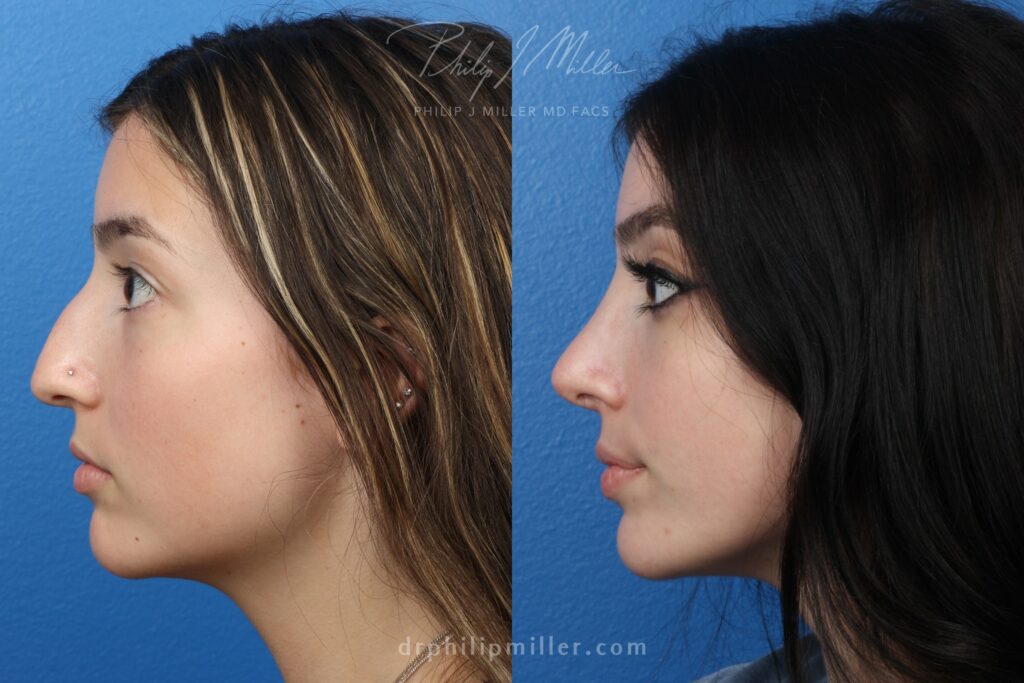
1. Zoom Boom Brings Rhinoplasty Boom
Because of the COVID-19 pandemic, 2020 was a challenging year for many businesses. But for Zoom, the video-conferencing giant, lockdown and working from home brought unprecedented growth.
Zoom usage jumped 67% between January 2020 and mid-March, when non-essential businesses and schools closed. The Zoom Boom also resulted in significant growth to an entirely different industry—cosmetic surgery.
The built-in cameras on our computers are clearly not designed to flatter the human face, and many people weren’t pleased with the reflection they saw on their computer screens.
The unflattering camera angle highlights facial flaws, such as wrinkling and sagging. People noticed unfamiliar lines, creases, and asymmetries as they saw themselves speaking on camera.
It’s not surprising that the Zoom phenomenon caused a booming demand for cosmetic procedures such as dermal injectables, laser treatments, and eye lifts.
On a Zoom conference call, the position of the computer’s camera relative to the user puts the focus on the center of the face, making the nose appear larger. As a result, demand for rhinoplasty significantly increased as well, and will likely continue into the New Year.
2. The Need for Natural

In Manhattan, Dr. Miller is renowned for the natural results he achieves for his patients, both with traditional rhinoplasty—for patients desiring more significant changes and permanent results—as well as non-surgical rhinoplasty, for patients seeking relatively minor corrections. As demands for natural results will continue to be a factor in 2022, Dr. Miller is prepared to deliver satisfying results to his New York patients.
Rhinoplasty, also known as a nose job, is a surgical procedure that can improve the appearance of the nose by reshaping, reducing, augmenting the tissue, removing a bump, or adjusting the angle between the nose and the mouth.
A major benefit of rhinoplasty is that it’s typically a “one-and-done” procedure. Once the surgery is complete and the nose has fully healed, patients can enjoy the improvements over their lifetime.
If you’re dissatisfied with your nose because of minor depressions or hollows that affect its overall appearance, non-surgical rhinoplasty may be the right solution for you. Non-surgical nose jobs are safe and effective, providing immediate results with exceptionally short recovery time. With this non-invasive procedure, injectable fillers are used to make small yet dramatic modifications to the nose.
Non-surgical rhinoplasty has its limitations, however. Since corrections are made with dermal fillers that ultimately dissolve, results aren’t permanent. Non-surgical nose jobs aren’t appropriate for every nose and can’t reduce the size of the nose.
Results will vary by patient, but the longevity of a non-surgical nose job is typically between 8-24 months. During your consultation, Dr. Miller will determine which fillers might help you achieve the best results and how long the improvement might last.
3. Faster Recovery Times
Plastic surgeons today are starting to use techniques to minimize post-procedure discomfort and healing time. Rhinoplasty is typically performed as an outpatient procedure under general anesthesia, and patients return home on the same day. While you may be up and moving within 24 hours, expect to take up to a week off from work or school as you heal.
For the first several days, you’ll need to keep your head elevated and apply ice packs to reduce swelling. Most swelling and bruising subsides within a week following rhinoplasty. Nasal dressings, splints, and sutures are removed at about seven days after surgery. At this point, any residual bruising can be effectively camouflaged with makeup. Most patients feel comfortable appearing in public at about 7-10 days post-surgery.
Swelling will continue to subside and the nose may continue to improve in definition for up to a year after surgery. However, beyond the first week, these changes are subtle and typically not noticed by others. Many patients are pleasantly surprised at how quickly they recover from rhinoplasty.
4. The Combination Approach
Achieving facial balance sometimes means making adjustments to the chin at the same time as the nose. Dr. Miller’s expertise with both procedures produces superior results.
 When rhinoplasty surgery is performed to improve the overall shape and appearance of a nose, a receding chin could diminish the aesthetic effect of the face, making it look unbalanced.
When rhinoplasty surgery is performed to improve the overall shape and appearance of a nose, a receding chin could diminish the aesthetic effect of the face, making it look unbalanced.
To achieve the best possible results with rhinoplasty, the proportions of the entire face must be considered. If your chin is well defined and proportionate to your new nose, your overall appearance will be aesthetically enhanced by rhinoplasty alone.
If you have a receding chin, however, chin augmentation surgery performed along with rhinoplasty surgery can give your face balance that rhinoplasty alone could not have achieved. Therefore, many board-certified plastic surgeons are beginning to suggest chin augmentation with rhinoplasty for certain patients.
Recovery after a chin implant takes around two weeks. You may experience swelling, tenderness, and bruising in the chin area immediately after the procedure, but most of these symptoms will diminish within about a week. Eating soft foods during the first week after surgery will help to make your recovery period more comfortable.
5. Image Morphing
The ability to “see” your results before surgery is a benefit that more patients are wanting from their rhinoplasty surgeon. At his Manhattan office, Dr. Miller uses computer imaging to help patients visualize their new nose before undergoing surgery. Besides helping communicate the goals of the patient to the surgeon before the procedure, image morphing also helps ensure patient expectations are in line with results.
If you have difficulty visualizing what your ‘after’ may look like, image morphing can help. While the final result may not be absolutely identical to the morphed picture, it provides a good idea of what you can expect.
The NatraLook Process
Aesthetic Confidence is the sense of empowerment we feel about the way we look, dress, design, and decorate. It dovetails with confidence in our abilities, intellect, and emotions. The NatraLook Process focuses exclusively on the look component of Aesthetic Confidence. The NatraLook Process is an enriching experience through which you explore and ultimately boost your aesthetic confidence by enhancing your appearance.
The NatraLook process evaluates and expands the typical plastic surgery experience into a safe, non-intimidating opportunity to explore your aesthetic confidence. It creates a unified vision of your desired result so that you and New York surgeon Dr. Philip Miller know what to expect.
Contact an Expert Plastic Surgeon to Learn More About Rhinoplasty in New York City
Whichever procedure you ultimately choose, Dr. Miller can help you achieve your goals. His approach combines art and science with skill and innovation, providing patients in Manhattan, New York, aesthetically pleasing, natural results that are always in style.
To learn more about rhinoplasty surgery and non-surgical nose jobs, contact us online or call our practice in New York. One of our patient advisers will be happy to help you.
Why Requesting A Celebrity’s Nose Isn’t Always Best for Rhinoplasty Goals
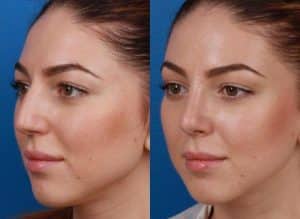
Simple, right? Not really. Whenever you plan on undergoing invasive cosmetic changes, there is one crucial factor that must be addressed: your EXPECTATIONS for your surgery. In this blog, I share some of my tips for managing your expectations about getting a nose job and one crucial element for getting the nose you will love.
Only Use Celebrity Noses As Inspiration
During a rhinoplasty consultation, I ask my patients to thoroughly discuss their desired results. This way, we can share a Unified Vision. A Unified Vision incorporates the patient’s aesthetic goals along with what I deem is surgically feasible with their given anatomy. Often times when we find certain individuals attractive, we naturally go about wanting to emulate their facial features. Celebrities under the spotlight often have variants of a slim, dainty nose that is turned-up, a.k.a. the celestial or “button nose.” My patients often bring in photos of celebrities; Jennifer Lopez, Kim Kardashian-West, Scarlett Johansson, Angelina Jolie, and Meghan Markle are amongst the most popular rhinoplasty examples.. Patients like to come prepared and bring in these photos as a point of reference for how they’d like their noses to turn out. I prefer my patients to bring in these photos because I use them as an effective communication tool to determine what the patient desires, as well as to see how realistic their expectations are.
The Goal of Rhinoplasty
I explain to my patients that the goal of a rhinoplasty procedure is to reshape the nose to create an overall improvement to the facial structure and aesthetic. In other words, a nose job can help you improve the balance of your facial features which ultimately will increase your self-confidence. But don’t expect that someone else’s nose will look right for your face. It should not be your goal to match somebody else’s appearance, but only take them as a source of inspiration. Everybody is unique in their facial features and therefore, should also be treated as such. I help my patients create a natural-looking nose that will complement their features and honor their ethnicity, rather than give them a “cookie-cutter nose” from a celebrity. To learn more about rhinoplasty, visit medlineplus.gov
Managing Realistic Expectations
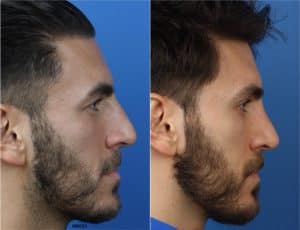
Consult With A Recognized Expert In Facial Plastic Surgery
Your realistic expectations for your nose job will serve as the foundation for your cosmetic surgery. And as the surgeon, I will become the foundation of its success. Rhinoplasty is a complex surgical procedure that requires experience, expert knowledge, and top-notch skills. To set yourself up for a successful journey, begin by choosing the best facial plastic surgeon. You can review the criteria here.
I am double board-certified in Facial Plastic and Reconstructive Surgery, as well as Otolaryngology/Head and Neck Surgery, and am considered one of the country’s leading experts in facial rejuvenation and rhinoplasty. I have lectured on innovative rhinoplasty techniques at the 10th International Symposium of Facial Plastic Surgery, and consistently since 2007, have been voted among the “Best Doctors in America” and “Top Doctor of New York.” It is my goal to help my patients find a look that makes them feel beautiful and confident. I combine my expertise, experience, skill, and artistic eye to deliver those life-changing results.
Are You Interested in a Rhinoplasty Consultation?
If you are interested in undergoing rhinoplasty, always remember to only trust your face to a world-class board-certified facial plastic surgeon, and be sure to communicate your expectations to achieve the most realistic outcome. To schedule a consultation with Dr. Miller, contact his office located at 60 East 56th Street, Third Floor in New York City, by calling (646) 791-3025
Read Next: Why Revision Rhinoplasties are So Common